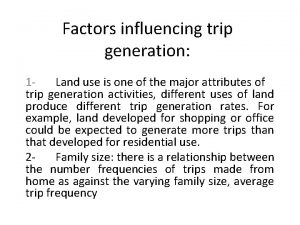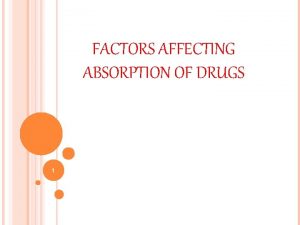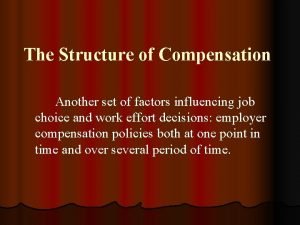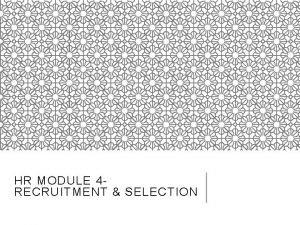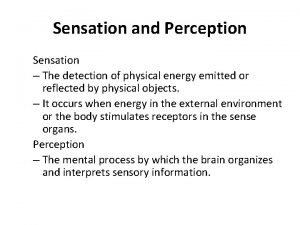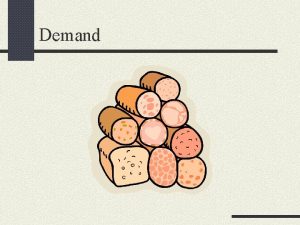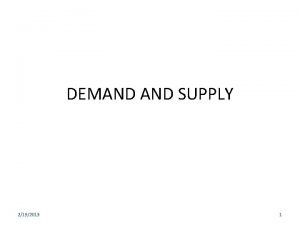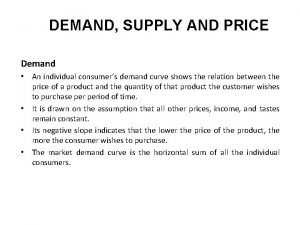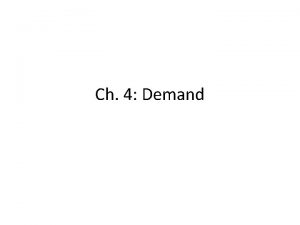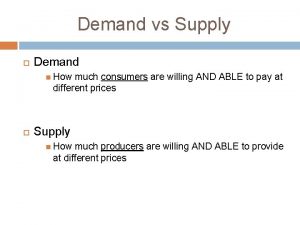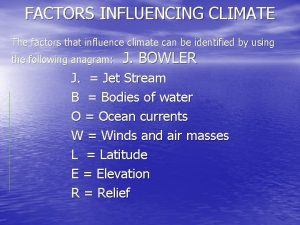2 Consumers demand analysis Structure Factors influencing an




































- Slides: 36

2. Consumer´s demand analysis

Structure Ø Factors influencing an individual demand Ø The impact of disposable income change: - income consumption curve, Engel curves - income elasticity of demand Ø The impact of the change of price of selected goods on the quantity demanded: - price consumption curve and demand derivation - substitution and income effect, Giffen paradox, price elasticity of demand Ø The impact of the change of price of other goods on the quantity demanded: - cross substitution effect, cross income effect - cross elasticity of demand Ø Relationship between demand elasticities, substitution elasticity Ø Derivation of market demand

Characteristics of an individual demand Individual demand = demand of the sole consumer. . . depends on: Ø disposable income Ø price of the selected goods Ø price of other goods Ø consumer´s preferences and expectations

The impact of the change of disposable income on the individual demand Ø all other factors remain the same Ø the change of disposable income moves the budget line. . . and the consumer´s equilibrium. . . Ø. . . ↑I → BL (+consumer´s equi. ) moves rightwards, ↓I → BL (+consumer´s equi. ) moves leftwards Ø ICC (Income Consumption Curve) = set of the consumer´s equilibria upon different levels of disposable income (or: IEP – Income Epansion Path)

Income consumption curve – standard path Y ICC IC 3 IC 2 IC 1 Growing income induces the growth of consumption of all „normal“ goods E 3 E 2 E 1 I 2 I 3 X

What is „normal“ goods? Ø. . . if the growth of disposable income induces the growth of Ø Ø Ø consumption of specific goods, we can say it is a „normal goods“, and. . . if the decrease of disposable income induces the decrease of consumption of specific goods, so. . . ↑I → ↑Q or ↓I → ↓Q essential goods – a subset of normal goods = if the growth/decrease of disposable income is relatively higher than the growth/decrease of the consumption: ↑I > ↑Q or ↓I > ↓Q luxury goods – a subset of normal goods = if the growth/decrease of disposable income is relatively smaller than the growth/decrease of the consumption: ↑I < ↑Q or ↓I < ↓Q the opposite of normal goods = inferior goods – the growth of disposable income induces the decrease of the consumption, and vice versa: ↑I → ↓ Q or ↓I → ↑ Q it depends on consumer´s preferences which goods is normal, or inferior

Application: EKC – Environmental Kuznets Curve Ø shows the relation between GDP per capita and the level of erosion of the environment Ø shape of inverse „U“ Ø explanation: environment is a luxury good – when the GDP/cap. is relatively low, people prefer everything but the clean environment, but when the GDP/cap. reaches a critical level, the demand for clean environment rises faster than the GDP/cap. does

Application: EKC – Environmental Kuznets Curve level of environment erosion EKC GDP/cap.

Income consumption curve – essential and luxury goods Y Y ICC E 2 E 1 X X is essential – its consumption grows slower than the disposable income X X is luxury – its consumption grows faster the disposable income

Income consumption curve – inferior goods Y ICC E 2 E 1 X X is inferior – consumption decreases while disposable income rises

Engel Curve - EC Ø shows the relation between the volume of goods consumption and the disposable income

Engel curve - derivation Y ICC E 3 E 2 E 1 X I 2 I 1 X 2 X 3 I 3 X EC X 3 X 2 X 1 I 2 I 3 I

Engel curve for essential, luxury and inferior goods X EC X X EC EC I X is essential – its consumption grows slower than the disposable income I X is luxury – its consumption grows faster the disposable income I X is inferior – consumption decreases while disposable income rises

Engel Expenditure Curve - EEC Ø represents the relation between the disposable income and total consumer´s expenditures on specific goods. . . Ø. . . the relation between P. Q and I

Engel expenditure curve for essential, luxury and inferior goods PX. X EEC EEC 45° I X is essential – expenditures on X grow slower than the disposable income 45° I X is luxury – expenditures on X grow faster the disposable income I X is inferior – expenditures on X decrease while disposable income rises

Income elasticity of demand Ø. . . reflects the sensitivity of consumer´s reaction to the change of disposable income and his/her consumption Ø it is a relative change of quantity demanded induced with the change of disposable income

Income elasticity of demand Ø e. ID = (ΔX/X)/(ΔI/I) or e. ID = (∂X/∂I/X/I) Ø e. ID> 0 for normal goods, e. ID < 0 for inferior goods Ø e. ID > 1 for luxury goods, 0 < e. ID < 1 for essential goods Ø sum of income elasticities of all consumed goods multiplied with the ratio of each good in the commodity cage must equal to 1 → μX. e. IDX + μY. e. IDY = 1, where: Ø μX. . . ratio of X, μY. . . ratio of Y Ø → if we buy a luxury good, we cannot avoid buying an inferior good either

The impact of the change of price of specific goods on the quantity demanded Ø we suppose the change of price of X, while everything else remains unchanged (price of Y and disposable income) Ø if the price of X changes, the BL changes its slope (BL rotates clock-wise, or anticlock-wise) Ø PCC (Price Consumption Curve)

Price consumption curve PCC = set of consumer´s equilibria upon different prices of specific good Y E 3 PCC E 1 E 2 X

PCC and the derivation of individual demand curve Y PCC P 1 P 2 X 1 X 2 P 3 X P 1 P 2 d. X P 3 X 1 X 2 X 3 X

Substitution and income effect – Hicks approach Ø Substitution Effect (SE) = change of quantity demanded resulting from the substitution of relatively more expensive good with the relatively cheaper good – SE is always negative, which means: ↓P → ↑X and vice versa, consumer moves along the original IC Ø Income Effect (IE) = change of quantity demanded resulting from the change of real disposable income – IE is negative for normal goods (↓P → ↑X and vice versa), and positive for inferior goods (↓P→↓X and vice versa), consumer moves to another IC Ø Note: IE increases the consumption of normal goods and decreases the consumption of inferior goods (in case of growing real income) Ø Total Effect (TE) = sum of SE + IE

Hicks decomposition on SE and IE – X is normal good Shift from A to B – substitution effect, the level of total utility remains constant Y Shift from B to C – income effect, shift to higher IC (higher level of total utility) Shift from A to C – total effect, sum of SE and IE A C B U 2 U 1 X SE IE TE

Hicks decomposition on SE and IE – X is inferior good Income effect counterworks the substitution effect – total effect still induces the growth of X consumption but not as much as in the case of normal good Y C A U 2 B U 1 X SE IE TE

Giffen good (Giffen paradox) Ø it is a subset of inferior goods Ø the decrease of price induces the decrease of quantity demanded and vice versa → individual demand curve has a positive slope Ø goods with relatively high ratio on total consumer´s expenditures; fulfils basic needs; there are no close substitutes Ø an important role of consumer´s expectations Ø i. e. basic food, fuel etc. during a crisis

Hicks decomposition on SE and IE – X is Giffen good Income effect counterworks the substitution effect, and IE>SE – total effect implies that if the price of X decreases, the quantity of X demanded is decreasing Y C U 2 A B U 1 SE IE TE X

Slutsky approach to the SE and IE Ø different approach to the substitution effect resulting from the change of price of goods Ø Hicks SE – consumer is able to reach the constant level of total utility after the relative prices change Ø Slutsky SE – consumer is able to reach the former commodity cage after the change of relative prices Ø Slutsky´s SE includes some of the Hicks´s IE

Slutsky decomposition on SE and IE – X is a normal good Shift from A to B – substitution effect, shift to the higher level of TU (broken lined IC) Y Shift from B to C – income effect, shitf to the higher (final) level of TU (IC marked U 2) A Shift from A to C – total effect, a sum of SE and IE C B U 2 U 1 X SE TE IE Intersection of A and subsidiary BL (broken lined BL): consumer is able to reach the former commodity cage but for the new relative prices

Price elasticity of demand Ø reflects the sensitivity of consumer´s reaction to the change of relative price of good and his/her quantity demanded Ø e. PD=(ΔX/X)/(ΔPX /PX) or e. PD=(∂X/∂PX/X/PX) Ø if e. PD= -1, then demand is unitarily elastic – relative change of quantity demanded is the same as the relative change of price Ø e. PD> -1, then demand is inelastic – relative change of quantity demanded is lower than the relative change of price Ø e. PD< -1, then demand is elastic – relative change of quantity demanded is higher than the relative change of price Ø e. PD> 0, then we talk about the Giffen paradox (Giffen good) – quantity demanded increases with increasing price and vice versa

The impact of the change of price of specific goods on the other goods quantity demanded Ø how the change of price of good X influences the quantity demanded of good Y, so: Ø how the consumer reflects the change of price of substitutes or complements Ø Cross SE – induces the substitution of relatively more expensive good with relatively cheaper good – is positive: ↑PY → ↑X and vice versa Ø Cross IE – induces the change of quantity demanded resulting from the change of real disposable income – is negative: ↑PY → ↓X Ø Cross TE – a sum of cross SE and cross IE – the direction depends on the relationship between the goods (substitutes or complements? )

Decomposition on cross SE and IE complements Shift from A to B – cross SE Shift from B to C – cross IE Y Shift from A to C – cross TE, a sum of cross SE and IE C B U 2 A In the case of complements the cross IE outweighs the cross SE – i. e. if the diesel gets cheaper (good Y), the demand for cars with diesel engines (good X) increases U 1 SE IE TE X

Decomposition on cross SE and IE substitutes Shift from A to B – cross SE Shif from B to C – cross IE Y Shift from A to C – cross TE, a sum of cross SE and IE In the case of substitutes the cross SE outweighs the cross IE – if coffee gets cheaper (good Y), the demand for black tea (good X) declines C B U 2 A U 1 SE IE TE X

Task: What are the cross effects in the case of perfect complements and/or perfect substitutes?

Cross elasticity of demand Ø reflects the relative change of quantity demand of specific good (godd X) reulsting from the relative change of price of the other good (good Y) / / Ø e. CD=(ΔX/X) (ΔPY /PY) or e. CD=(∂X/∂PY X/PY) Ø if e. CD > 0, then X and Y are substitutes Ø if e. CD < 0, then X and Y are complements Ø for the sum of all three kinds of elasticities stands: e. ID + e. PD + e. CD = 0. . . why?

Elasticity of substitution Ø reflects the relative change of the ratio of substitution of goods with each other. . . Ø. . . a variable that implies the shape of indifference curves Ø σ = Δ(Y/X) : Δ(MRSC) Y/X MRSC Ø σ = ∞ for perfect substitutes Ø σ = 0 for perfect complements

Derivation of market demand Ø market demand is the horizontal sum of all individual demands (demands of all consumers) for the specific good

Derivation of market demand Individual demands of „green“ and „red“ consumer P Market demand = demand of „green“ consumer + demand of „red“ consumer P DG 6 6 DT 3 3 DR 4 8 15 Q 8 23
 All about food chains
All about food chains Producers primary consumers secondary consumers
Producers primary consumers secondary consumers Define dynamic personality
Define dynamic personality Oxidation weathering diagram
Oxidation weathering diagram Rowan plan
Rowan plan Physical factors influencing agriculture
Physical factors influencing agriculture What is the shape of the trajectory of a projectile? *
What is the shape of the trajectory of a projectile? * Florence nightingale definition
Florence nightingale definition Factors influencing trip attraction
Factors influencing trip attraction Factors influencing international pricing
Factors influencing international pricing A model of destination image formation
A model of destination image formation Factors of influencing communication
Factors of influencing communication Factors influencing maternal health
Factors influencing maternal health Local factor affecting wound healing
Local factor affecting wound healing Factors influencing faculty staff relationship
Factors influencing faculty staff relationship What are the objectives of plant layout
What are the objectives of plant layout Factors influencing supply chain network design
Factors influencing supply chain network design Physical factors influencing agriculture
Physical factors influencing agriculture Factor affecting consensus
Factor affecting consensus Factors influencing chemical weathering
Factors influencing chemical weathering Distributor storage with last mile delivery
Distributor storage with last mile delivery Factors affecting oxygenation in nursing
Factors affecting oxygenation in nursing Physical factors influencing agriculture
Physical factors influencing agriculture Simple carburetor
Simple carburetor Factors influencing t&d
Factors influencing t&d Psychological factors influencing learning
Psychological factors influencing learning Factors affecting absorption of drug
Factors affecting absorption of drug Conclusion of exceptional child
Conclusion of exceptional child Designing distribution network
Designing distribution network Factors influencing compensation philosophy
Factors influencing compensation philosophy Manufacturer storage with direct shipping example
Manufacturer storage with direct shipping example Cross tooth cross arch balance
Cross tooth cross arch balance 3 factors that affect recruitment and selection
3 factors that affect recruitment and selection Factors influencing human resource management
Factors influencing human resource management Mask ppe meaning
Mask ppe meaning Modus tolen
Modus tolen Factors affecting attention ppt
Factors affecting attention ppt








